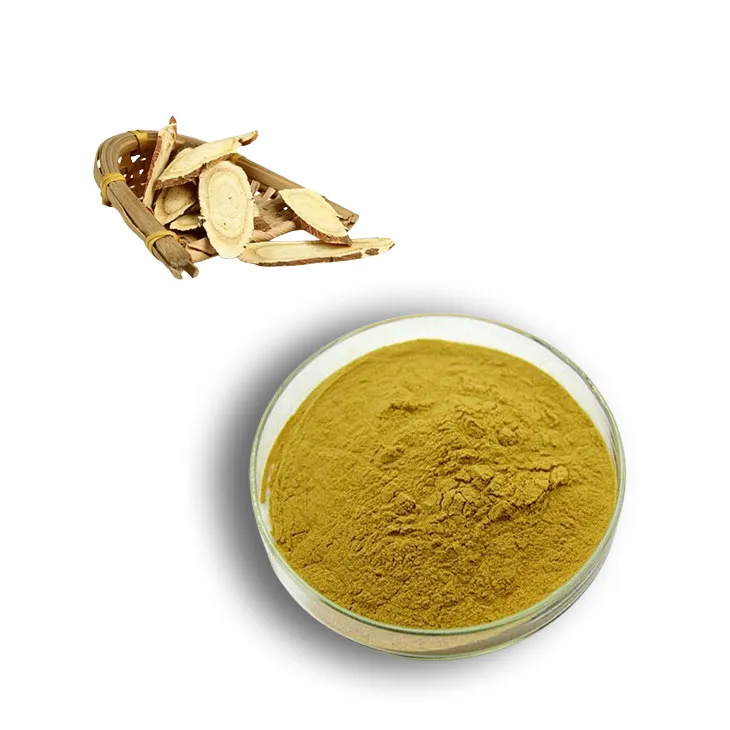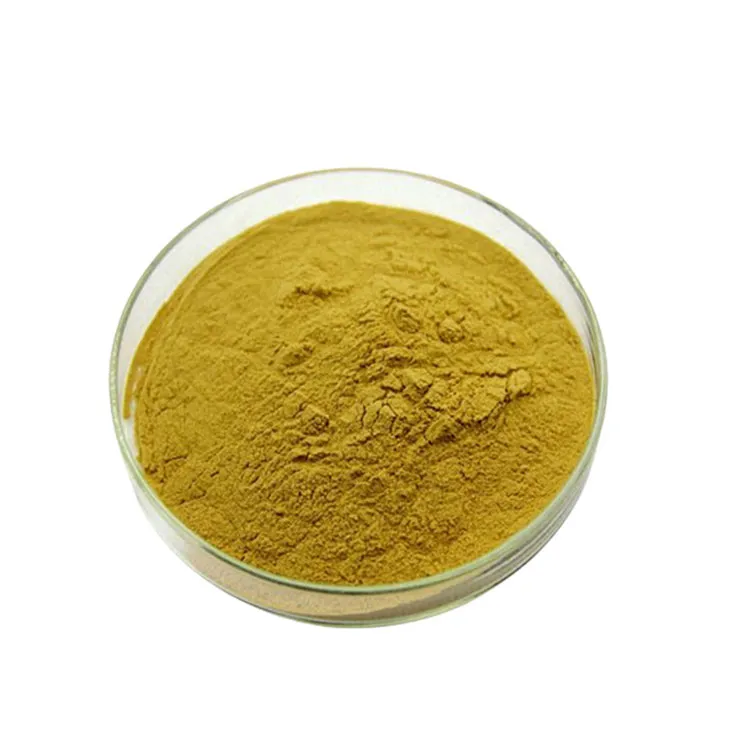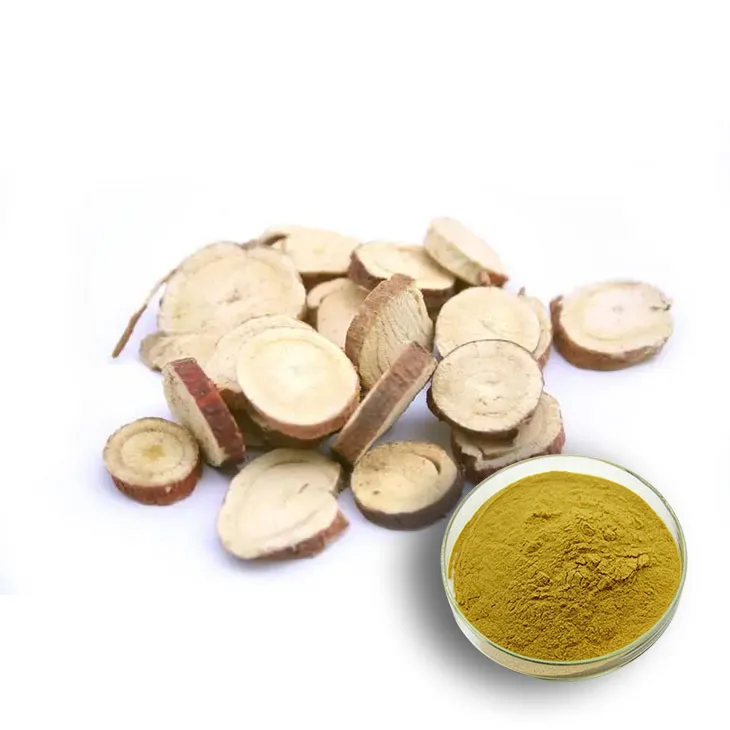- 0086-571-85302990
- sales@greenskybio.com
Optimal Bioavailability of Licorice Root Extract Powder.
2024-11-30

1. Introduction
Licorice Root Extract Powder has emerged as a subject of significant interest in recent years, primarily due to its potential health benefits. This natural extract has been used in traditional medicine for centuries, and modern research is gradually uncovering the scientific basis behind its efficacy. However, for its full potential to be realized, understanding its bioavailability is crucial. Bioavailability refers to the proportion of a drug or other substance that enters the circulation when introduced into the body and so is able to have an active effect. In the case of Licorice Root Extract Powder, various factors can influence how much of its active components are actually available for the body to utilize.

2. The Active Components of Licorice Root Extract
Licorice root contains a variety of bioactive compounds. One of the most well - known is glycyrrhizin, which gives licorice its characteristic sweet taste. Glycyrrhizin has been shown to have anti - inflammatory, antiviral, and antimicrobial properties. Another important component is flavonoids, such as liquiritin and isoliquiritin. These flavonoids are thought to contribute to the antioxidant and anti - cancer activities associated with licorice root extract. Understanding the nature of these active components is the first step in exploring their bioavailability.

3. Extraction Methods and Bioavailability
3.1 Traditional Extraction
Traditional extraction methods for Licorice Root Extract Powder include solvent extraction, often using water or ethanol. These methods can be relatively simple but may not always yield the highest bioavailability. For example, when using water extraction, some of the lipophilic (fat - soluble) components of licorice root may not be efficiently extracted. This can limit the overall bioactivity of the extract as these components may play important roles in the body's response to the extract.
3.2 Modern Extraction Techniques
Modern extraction techniques, such as supercritical fluid extraction (SFE) and microwave - assisted extraction (MAE), offer potential improvements in bioavailability. Supercritical fluid extraction uses a supercritical fluid, typically carbon dioxide, as the solvent. This method can selectively extract different components of licorice root more efficiently compared to traditional solvents. It can also avoid the use of toxic solvents, which is an added advantage. Microwave - assisted extraction on the other hand, uses microwave energy to speed up the extraction process. This can help to preserve the integrity of the active components and may lead to higher bioavailability as the components are less likely to be degraded during extraction.

4. Formulation and Bioavailability
4.1 Capsule Formulations
Capsule formulations are a common way to deliver licorice root extract powder. The type of capsule material can have an impact on bioavailability. For example, hard gelatin capsules may protect the extract from degradation in the stomach acid to some extent, but they may also delay the release of the extract. Enteric - coated capsules can be designed to pass through the stomach intact and release the extract in the intestine, where the absorption may be more favorable for some of the components of licorice root extract. This can potentially increase the bioavailability as it allows for a more targeted delivery of the active components.
4.2 Tablet Formulations
Tablet formulations also require careful consideration. Compression during tablet formation can affect the physical properties of the extract powder. If the pressure is too high, it may lead to the degradation or alteration of the active components. Additionally, the addition of excipients in tablet formulations can either enhance or reduce bioavailability. For example, some disintegrants can help break down the tablet quickly in the gastrointestinal tract, facilitating the release and absorption of the extract, while some fillers may interfere with the absorption process.

5. Interaction with the Body
5.1 Gastrointestinal Absorption
The process of gastrointestinal absorption is a key determinant of bioavailability for licorice root extract powder. In the stomach, the acidic environment can affect the stability of the extract. Some components may be hydrolyzed or otherwise chemically modified, which can change their bioavailability. In the intestine, the presence of various enzymes and transporters plays a role. For example, some flavonoids in licorice root extract may be substrates for specific transporters, and the efficiency of these transporters can influence how much of the flavonoids are absorbed into the bloodstream.
5.2 Metabolism in the Body
Once absorbed, the components of licorice root extract are metabolized in the body. Glycyrrhizin, for example, is metabolized in the liver. The metabolites of glycyrrhizin may have different biological activities compared to the parent compound. Understanding these metabolic pathways is important as it can help in predicting the long - term effects of licorice root extract consumption. Additionally, individual differences in metabolism, such as genetic polymorphisms in enzymes involved in the metabolism of licorice root components, can lead to variations in bioavailability among different individuals.
6. Strategies to Maximize Bioavailability
To maximize the bioavailability of licorice root extract powder, a combination of strategies can be employed. Firstly, choosing the most appropriate extraction method, such as modern techniques like SFE or MAE, can ensure a higher yield of intact active components. Secondly, formulating the extract in a way that is optimized for absorption, such as using enteric - coated capsules or tablets with appropriate disintegrants. Thirdly, considering the individual factors that may affect absorption and metabolism, such as genetic factors, and tailoring the use of licorice root extract accordingly. For example, individuals with certain genetic polymorphisms may require different dosages or forms of the extract to achieve the optimal bioavailability.
7. Conclusion
In conclusion, licorice root extract powder holds great promise in terms of its potential health benefits. However, to fully realize these benefits, it is essential to understand and optimize its bioavailability. By considering factors such as extraction methods, formulation, and interaction with the body, we can take steps to maximize the efficacy of this valuable natural extract. Further research is still needed in many areas, such as exploring new extraction techniques and understanding the full extent of individual variability in bioavailability. But with continued investigation, licorice root extract powder has the potential to be more effectively utilized in promoting health and well - being.
FAQ:
What are the main extraction methods of licorice root extract powder?
Common extraction methods of licorice root extract powder include solvent extraction, such as using ethanol or water as solvents. Solvent extraction can help to dissolve and separate the active components from the licorice root. Another method is supercritical fluid extraction, which uses supercritical carbon dioxide. This method has the advantage of being more environmentally friendly and can often obtain a purer extract with better quality control over the active ingredients.
How does the formulation affect the bioavailability of licorice root extract powder?
The formulation plays a crucial role in bioavailability. For example, if the licorice root extract powder is formulated into a capsule or tablet, the dissolution rate of the outer shell can impact how quickly the extract is released in the body. A well - designed formulation that allows for proper disintegration and dissolution in the gastrointestinal tract will enhance the bioavailability. Additionally, combining the extract with certain excipients that can improve solubility or permeability can also increase its bioavailability.
What are the potential health benefits of licorice root extract powder?
Licorice root extract powder may have several potential health benefits. It has been associated with anti - inflammatory properties, which can be helpful in reducing inflammation in the body. It may also have antioxidant effects, helping to combat oxidative stress. Some studies suggest that it can have a positive impact on the digestive system, potentially soothing the stomach and improving digestion. Additionally, there are indications that it could play a role in modulating the immune system.
How does licorice root extract powder interact with the body?
When ingested, licorice root extract powder interacts with various systems in the body. In the digestive system, it may interact with enzymes and receptors in the gut lining. For example, it can affect the absorption of nutrients or influence the gut microbiota. Once absorbed into the bloodstream, it can interact with cells throughout the body. Some of its active components may bind to specific receptors on cells, triggering various biochemical responses such as modulating gene expression or influencing cellular signaling pathways related to inflammation and immunity.
What factors can reduce the bioavailability of licorice root extract powder?
Factors that can reduce the bioavailability include poor solubility. If the extract powder has low solubility in the gastrointestinal fluids, it will not be effectively absorbed. Also, interactions with other substances in the diet or medications can be a problem. For instance, if taken with certain drugs that interfere with its absorption or metabolism, the bioavailability may be decreased. Additionally, improper storage conditions that lead to degradation of the active components can also reduce its bioavailability.
Related literature
- Bioavailability and Pharmacokinetics of Licorice Compounds"
- "The Influence of Extraction Techniques on the Bioactivity of Licorice Root Extract"
- "Formulation Strategies to Enhance the Bioavailability of Natural Extracts: A Case of Licorice Root"
- ▶ Hesperidin
- ▶ citrus bioflavonoids
- ▶ plant extract
- ▶ lycopene
- ▶ Diosmin
- ▶ Grape seed extract
- ▶ Sea buckthorn Juice Powder
- ▶ Beetroot powder
- ▶ Hops Extract
- ▶ Artichoke Extract
- ▶ Reishi mushroom extract
- ▶ Astaxanthin
- ▶ Green Tea Extract
- ▶ Curcumin Extract
- ▶ Horse Chestnut Extract
- ▶ Other Problems
- ▶ Boswellia Serrata Extract
- ▶ Resveratrol Extract
- ▶ Marigold Extract
- ▶ Grape Leaf Extract
- ▶ blog3
- ▶ blog4
-
The Most Highly - Praised Seabuckthorn Oil.
2024-11-30
-
Wholesale Acai Berry Extract Suppliers.
2024-11-30
-
The best artichoke leaf extract from nature.
2024-11-30
-
Optimal Bioavailability of Green Tea Extract
2024-11-30
-
Yohimbine Bark Extract
2024-11-30
-
White Willow Bark Extract
2024-11-30
-
Red Vine Extract
2024-11-30
-
Diosmin
2024-11-30
-
Avocado Extract Powder
2024-11-30
-
Maca Extract
2024-11-30
-
Chaste Berry Extract
2024-11-30
-
Okra Extract
2024-11-30
-
Tamarind extract powder
2024-11-30
-
Reishi mushroom extract
2024-11-30





















